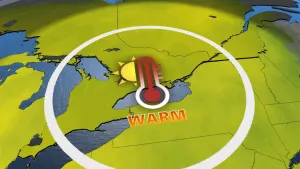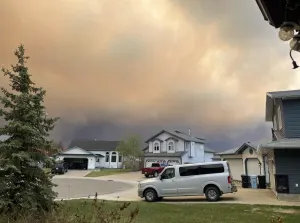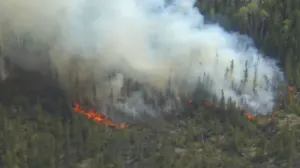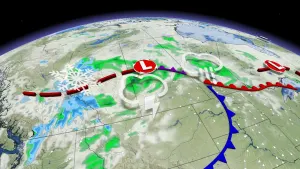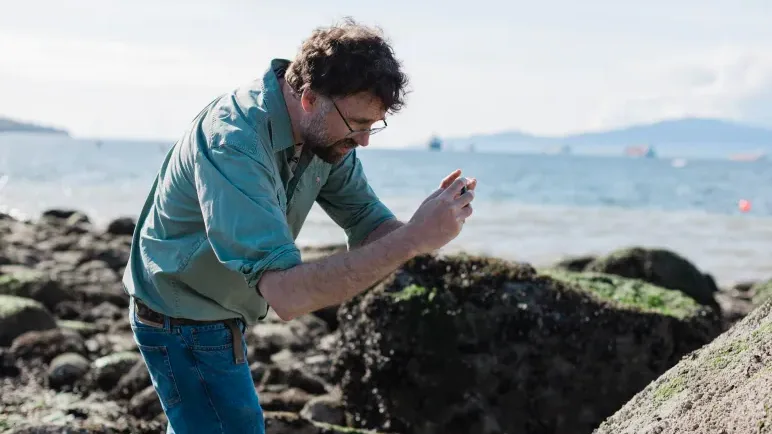
After mass sea animal die-off in B.C. heat dome, researchers search for new life
Our planet is changing. So is our journalism. This story is part of a CBC News initiative entitled "Our Changing Planet" to show and explain the effects of climate change. Keep up with the latest news on our Climate and Environment page.
At the height of B.C.'s heat dome in June of 2021, Chris Harley, a professor at UBC's Department of Zoology, headed to West Vancouver's Lighthouse Park to measure water temperatures and observe how the marine animals that inhabit B.C.'s coastlines were faring under the extreme conditions.
He anticipated seeing some degree of die-off, but instead was greeted with the overwhelming stench of rotting flesh as sea creatures cooked in the open air, their shells popping open.
In the days that followed, Harley and his students estimated that billions of sea creatures died as temperatures soared above 40 C, and water temperatures reached as high as 56 C.
Ten months after the catastrophe on B.C.'s shores, the researchers have returned to comb B.C.'s beaches, checking for signs that the vital populations of seaweed, crustaceans and shellfish native to the coast are seeing a resurgence.
"There are some reasons for optimism. Seeing the wee little juvenile barnacles coming in is a good sign. But the system has been disrupted," said Harley, who has studied shorelines on the West Coast since 1995.
"Yesterday I was down closer to White Rock and it still looks like a bomb has gone off down there — lots of death and destruction."

Harley said while the ecosystem is showing promising signs of resilience, it is now uniquely vulnerable to the dangers of another heat dome. And the collapse of even one population has cascading effects on others. For example, many of the rocks usually slicked green and brown with seaweed are now bare, leaving the baby barnacles exposed to the sun.
"Once all the species are back, we know that a diverse ecosystem is more resistant to that sort of insult. But if you get another big disturbance, another big heat wave before the ecosystem has a chance to recover, that can actually do more damage than it would have otherwise," said Harley.
Harley and his students have studied the coastlines from Victoria to Sooke and White Rock, and as far north as Bamfield, Puget Sound, and the Strait of Georgia. They measure the number of sea creatures repopulating by conducting random quadrant searches — laying down a square and counting the creatures that fall inside it, then scaling up to estimate mortality.
Early findings indicate species with mobility had a higher survival rate, thanks to their ability to find shade and cooler enclaves. But those anchored to rocks, like starfish and shellfish, fared worse. Barnacles and mussels planted on the north sides of rocks often survived, while those on the south side of the rock are, in many places, entirely gone.

Ten months after the catastrophe on B.C.'s shores, researchers have returned to comb its beaches, checking for signs that the vital populations of seaweed, barnacles, mussels, starfish and crabs native to the coast are seeing a resurgence. (Gian Paolo Mendoza/CBC)
Harley warns B.C.'s beaches and waters will transform if species like mussels and barnacles are replaced by populations that thrive in warmer temperatures.
"Mussels and barnacles filter out a lot of the gunk in the water. What would False Creek look like if we lost those filters or replaced them with something that might work a little bit differently? There are questions that we hadn't even thought to ask prior to last summer, because we weren't expecting this sort of thing to happen this quickly," he said.
"I expect in another five, 10, 15 years, this is going to be, instead of a mussel-dominated shore, it's going to be more of an oyster-dominated shore. And it might actually look like subtropical parts of of East Asia at that point."
Harley and his students aren't the only group looking at how climate change is impacting the waters off B.C.
William Cheung, a marine biologist at UBC, analyzed 340 menus from restaurants in the Vancouver area between 1880 and 2021 as he searched for alternate data sets to determine how climate change will affect fish populations.
His research, which also looked at restaurant menus from Anchorage and Los Angeles, found the preferred water temperature of the seafood getting served up to customers is getting warmer and warmer.
"We found a significant increase in the temperature of the seafoods that restaurants are serving since the 1980s," said Cheung.
"One of the interesting things is that increase relates closely to changes in seawater temperature, as well as the composition of species that fishermen are catching in relation to changing temperatures over that period."

William Cheung, a marine biologist at UBC, analyzed 340 menus from restaurants in the Vancouver area between 1880 and 2021 as he searched for alternate data sets to determine how climate change will affect fish populations. (Gian Paolo Mendoza/CBC)
Cheung said the Humboldt squid, a warm water species, was hardly found on restaurant menus before the 1990s, but has popped up more and more frequently in recent years. He also projects that sardines, a warm-watered species that faced population collapse in the 1950s, will once again become a staple of restaurant menus in B.C. as they swim up the current to warmer waters.
But salmon, a favourite of many British Columbians, could be far less available in the near future as they face habitat collapse.
"People might think climate change effects in the oceans are remote, but our study shows that climate change is affecting everyone," said Cheung.
Harley said he's hopeful that the populations of barnacles and mussels have proven resilient — but he remains concerned about the potential for another dangerous heat wave in 2022.
"The analogy that I use is when you get a sunburn, that's bad. If you get a second sunburn before the first one heals, that's when you're more likely to get skin cancer. And the system hasn't healed yet," he said.
"I think ecologists like myself are caught a little bit on the back foot because things are changing faster than we had expected them to."
This article, written by Michelle Ghoussoub, was originally published for CBC News.







